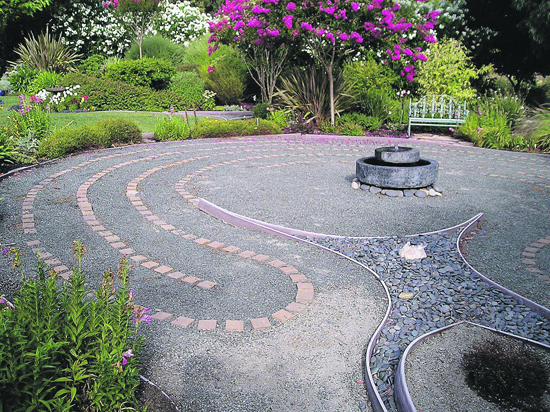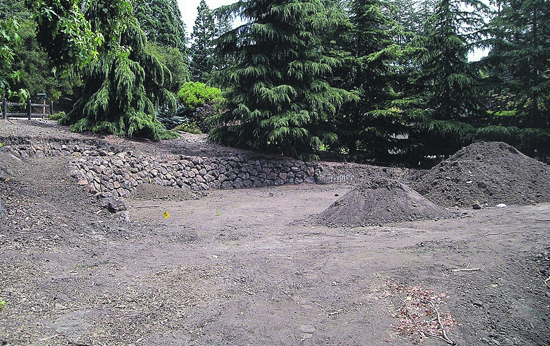 | | | Backyard Baltic Wheel labyrinth in Lafayette Photos Cathy Dausman
| | | | | | The pace of life in Lamorinda can sometimes make people feel as if they're running in circles. Oddly enough, some seek out another circle to quiet the mind and disconnect. They walk the labyrinth.
 Early references to the labyrinth date to ancient Greece. Labyrinth designs show up on ancient coins. In the Middle Ages in Europe churches built labyrinths. Labyrinth designs follow the Chartres, Baltic, Classical, and Concentric manner. A person winding along a 30 foot diameter labyrinth route ends up walking over 100 yards. Technically speaking, a labyrinth is not a maze. A maze has built-in dead ends; a labyrinth always leads the walker to its center. No one gets lost, except in thought, walking a labyrinth.
Early references to the labyrinth date to ancient Greece. Labyrinth designs show up on ancient coins. In the Middle Ages in Europe churches built labyrinths. Labyrinth designs follow the Chartres, Baltic, Classical, and Concentric manner. A person winding along a 30 foot diameter labyrinth route ends up walking over 100 yards. Technically speaking, a labyrinth is not a maze. A maze has built-in dead ends; a labyrinth always leads the walker to its center. No one gets lost, except in thought, walking a labyrinth.
 Labyrinths are found in buildings and outside, in churches, private backyards and parks. They can be built from rock, lighted candles, groomed from grass or plants, or carved into stone. There is labyrinth art, music, books, workshops, and even labyrinth soaps. There are labyrinth designers, contractors and tours.
Labyrinths are found in buildings and outside, in churches, private backyards and parks. They can be built from rock, lighted candles, groomed from grass or plants, or carved into stone. There is labyrinth art, music, books, workshops, and even labyrinth soaps. There are labyrinth designers, contractors and tours.
 An online search referenced 18 labyrinths in a 10 mile radius of Lamorinda. According to www.labyrinthlocator.com, San Francisco's Grace Cathedral has a labyrinth, as does Danville's San Damiano retreat house. A stone labyrinth is located along the Seaview Trail in Tilden Park. Another, Mazzariello's Labyrinth, is in the Sibley Volcanic Regional Preserve (Sibley Park). Walnut Avenue United Methodist Church in Walnut Creek has two. And three Lamorinda churches have, or are building, labyrinths. Reverend Jan Holland of St. Stephen's Episcopal Church, Orinda calls the labyrinth "an ancient Christian walking meditation." She says it is a spiritual tool which evolved from the medieval practice of making a pilgrimage to Jerusalem. Walking the labyrinth became an acceptable substitute for taking the trip. Holland and her husband, Reverend Larry Hunter, recently returned from an overseas trip which included a visit to the famed labyrinth in France's Chartres Cathedral. Holland's first labyrinth experience was ten years ago. This summer St. Stephen's broke ground on its own outdoor labyrinth. Two years in the planning, it is scheduled to be finished the end of October. For Holland, having a labyrinth at her church is "the fruition of a dream." Holland cites Walking a Sacred Path by Lauren Artress as a good reference.
An online search referenced 18 labyrinths in a 10 mile radius of Lamorinda. According to www.labyrinthlocator.com, San Francisco's Grace Cathedral has a labyrinth, as does Danville's San Damiano retreat house. A stone labyrinth is located along the Seaview Trail in Tilden Park. Another, Mazzariello's Labyrinth, is in the Sibley Volcanic Regional Preserve (Sibley Park). Walnut Avenue United Methodist Church in Walnut Creek has two. And three Lamorinda churches have, or are building, labyrinths. Reverend Jan Holland of St. Stephen's Episcopal Church, Orinda calls the labyrinth "an ancient Christian walking meditation." She says it is a spiritual tool which evolved from the medieval practice of making a pilgrimage to Jerusalem. Walking the labyrinth became an acceptable substitute for taking the trip. Holland and her husband, Reverend Larry Hunter, recently returned from an overseas trip which included a visit to the famed labyrinth in France's Chartres Cathedral. Holland's first labyrinth experience was ten years ago. This summer St. Stephen's broke ground on its own outdoor labyrinth. Two years in the planning, it is scheduled to be finished the end of October. For Holland, having a labyrinth at her church is "the fruition of a dream." Holland cites Walking a Sacred Path by Lauren Artress as a good reference.
 Lafayette Orinda Presbyterian Church (LOPC) is home to a permanent outdoor labyrinth located at the church's main entrance. The labyrinth, designed into the stone walkway, was built in September, 2006 when the entrance was remodeled for handicap accessibility. Karlene Paufler, chair of the church's Labyrinth Committee, has walked labyrinths across the U.S. and in Europe. She says each labyrinth has a different feel, and "once you've done it...it's addictive," and "you don't have to think about where you're going."
Lafayette Orinda Presbyterian Church (LOPC) is home to a permanent outdoor labyrinth located at the church's main entrance. The labyrinth, designed into the stone walkway, was built in September, 2006 when the entrance was remodeled for handicap accessibility. Karlene Paufler, chair of the church's Labyrinth Committee, has walked labyrinths across the U.S. and in Europe. She says each labyrinth has a different feel, and "once you've done it...it's addictive," and "you don't have to think about where you're going."
 LOPC now opens its labyrinth to the public several times a year for what they call a sacred journey. The experience often includes instrumental music and attendance numbers about 60. Its March labyrinth walk was well attended even after rain officially cancelled the event. LOPC's next labyrinth walk is scheduled from 7:00 to 8:00 p.m. on September 9; see www.lopc.org/home.asp for details.
LOPC now opens its labyrinth to the public several times a year for what they call a sacred journey. The experience often includes instrumental music and attendance numbers about 60. Its March labyrinth walk was well attended even after rain officially cancelled the event. LOPC's next labyrinth walk is scheduled from 7:00 to 8:00 p.m. on September 9; see www.lopc.org/home.asp for details.
 David Starkweather and Anna Johnson co-chair the Orinda Community Church Labyrinth Committee. Committee research discovered the Bay Area is home to 80 labyrinths, in schools, churches, and backyards. They also learned that the labyrinth is a valuable therapy for those with memory impairment. Starkweather says the church first built temporary labyrinths from luminarias (candles in paper bags) on their property. Next they borrowed a canvas labyrinth from a church in Pleasant Hill. They then bought a Classic design canvas labyrinth, a "perfect fit" for their fellowship hall. It is used during special Christmas and Easter services.
David Starkweather and Anna Johnson co-chair the Orinda Community Church Labyrinth Committee. Committee research discovered the Bay Area is home to 80 labyrinths, in schools, churches, and backyards. They also learned that the labyrinth is a valuable therapy for those with memory impairment. Starkweather says the church first built temporary labyrinths from luminarias (candles in paper bags) on their property. Next they borrowed a canvas labyrinth from a church in Pleasant Hill. They then bought a Classic design canvas labyrinth, a "perfect fit" for their fellowship hall. It is used during special Christmas and Easter services.
 Martha Engelbert built a garden labyrinth in her Lafayette area home in the late 1990's after she and her daughter took a guided tour of labyrinths in France, Germany and Switzerland. When they returned, the pair designed an "easy to make" Baltic Wheel labyrinth from gravel and brick. (The Baltic Wheel pattern is a modest five circuit labyrinth good for limited spaces. Larger, more elaborate labyrinths call for 11 circuits.) Engelbert and her Pleasant Hill church friends use the labyrinth, which she named Oasis, regularly. "It's a marvelous way to be centered," she says.
Martha Engelbert built a garden labyrinth in her Lafayette area home in the late 1990's after she and her daughter took a guided tour of labyrinths in France, Germany and Switzerland. When they returned, the pair designed an "easy to make" Baltic Wheel labyrinth from gravel and brick. (The Baltic Wheel pattern is a modest five circuit labyrinth good for limited spaces. Larger, more elaborate labyrinths call for 11 circuits.) Engelbert and her Pleasant Hill church friends use the labyrinth, which she named Oasis, regularly. "It's a marvelous way to be centered," she says.
 To learn more go online to http://www.labyrinthsociety.org/.
To learn more go online to http://www.labyrinthsociety.org/.

|


